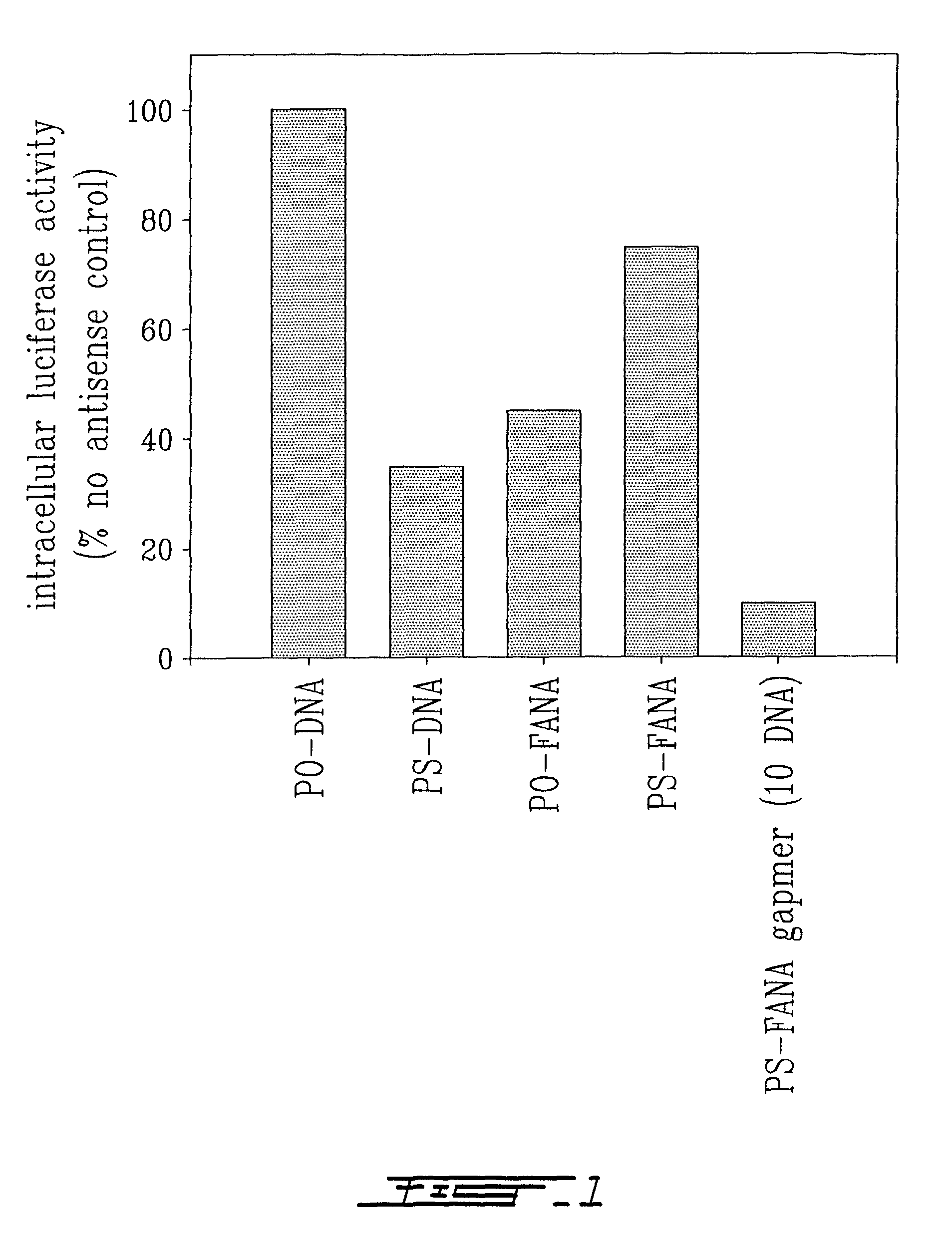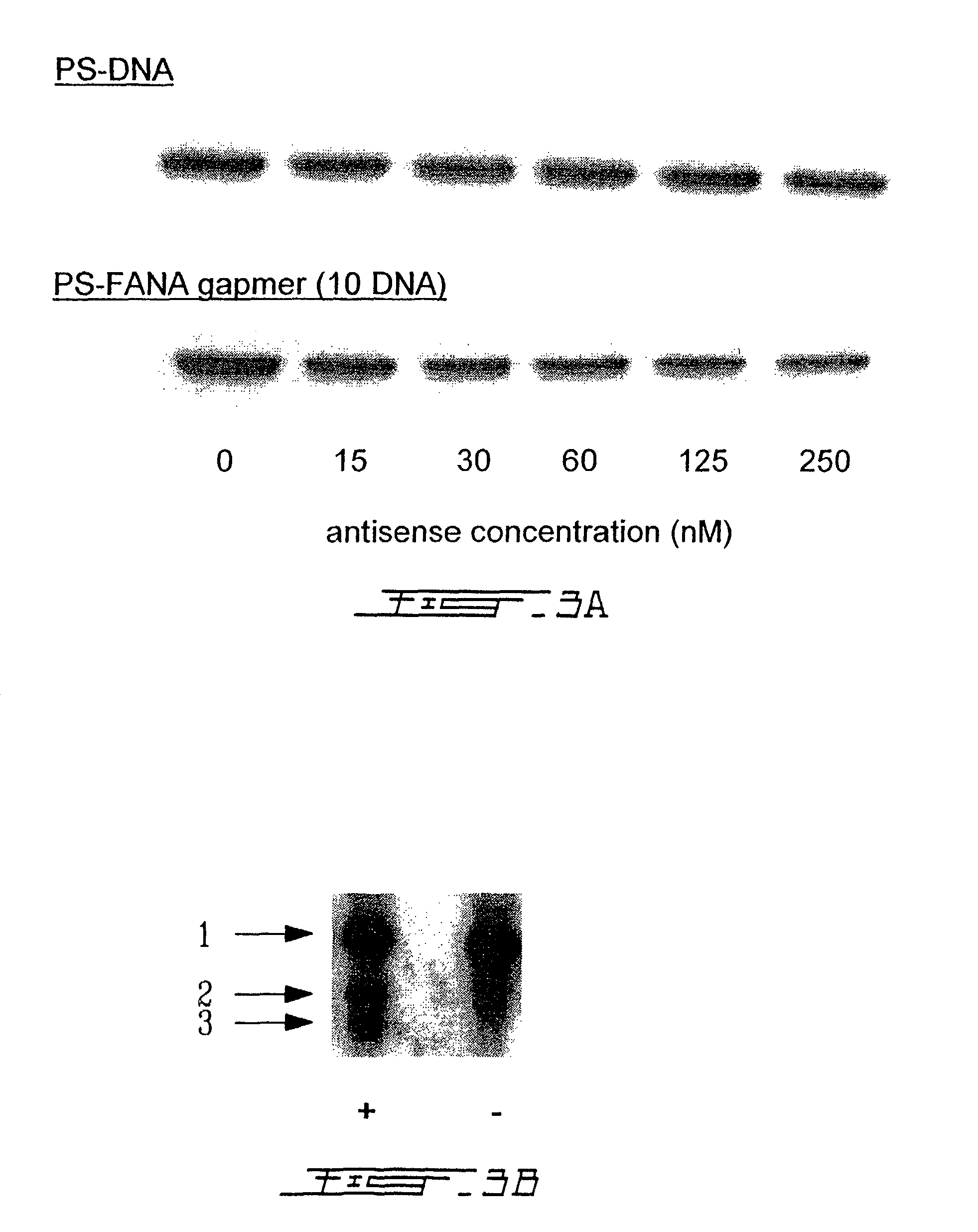Chimeric antisense oligonucleotides of arabinofuranose analogue and deoxyribose nucleotides
- Summary
- Abstract
- Description
- Claims
- Application Information
AI Technical Summary
Benefits of technology
Problems solved by technology
Method used
Image
Examples
example i
Preparation of Antisense Oligonucleotides Constructed from 2′-deoxy-2′-fluoro-β-D-arabinonucleotides (FANA) Flanking a Defined Sequence Constructed from β-D-2′-deoxyribonucleotides (DNA)
1. Synthesis of FANA, S-[FANA], and S-[FANA-DNA-FANA]
[0071]The synthesis of PO-FANA was conducted as previously described (Damha et al. J. Am. Chem. Soc. 120, 12976-12977 (1998). Synthesis of S-FANA and S-[FANA-DNA-FANA] chimeras were synthesized on a 1 micromol scale using an Expedite 8909 DNA-synthesizer. Long-chain alkylamine controlled-pore glass (LCAA-CPG) was used as the solid support. The synthesis cycle consisted of the following steps:[0072]1) Detritylation of nucleoside / tide bound to CPG (3% trichloroacetic acid / dichloromethane): 150 sec.[0073]2) Coupling of 2′-F-arabinonucleoside or 2′-deoxyribonucleoside 3′-phosphoramidite monomers: 15 min. Concentration of monomers used were 50 mg / mL for araF-T, araF-C and DNA monomers, and 60 mg / mL for araA and araF-G (acetonitrile as solvent).[0074]3) ...
example 2
Efficacy of Various Antisense Oligonucleotides to Inhibit Intracellular Gene Expression
[0086]Antisense oligonucleotides have the potential to inhibit expression of virtually any gene, based on the specific base sequence of the chosen target mRNA. We studied the ability of antisense oligonucleotides constructed from 2′-deoxy-2′-fluoro-β-D-arabinonucleotides (FANA) flanking a series of 2′-deoxyribose nucleotide residues of variable length (S-FANA gapmer) to interfere with the expression of a well-characterized marker model, namely expression of the enzyme luciferase, in cells stably transfected with the luciferase gene. The efficacy of the S-FANA gapmer to inhibit intracellular luciferase expression was compared with identical sequence antisense oligonucleotides constructed entirely from 2′-deoxy-2′-fluoro-β-D-arabinonucleotides or entirely from 2′-deoxyribonucleotides. Linkages between nucleotides were either phosphodiester (PO) or phosphorothioate (PS). The specific antisense oligon...
example 3
Comparison of S-DNA and S-FANA Gapmer (10 DNA) Antisense Oligonucleotides to Inhibit Intracellular Gene Expression
[0092]Solutions of S-DNA (ID# 11, Table 1) and S-FANA gapmer (ID# 1, Table 1) were prepared with Cytofectin GSV GS3815 as described in Example 2. Hela X1 / 5 cells were plated in replicate 6-well plates at a density of 5×105 cells / well and allowed to grow for 24 h in DMEM / 10% FBS. The culture medium was then removed from the cells, the cells were washed several times with phosphate-buffered saline, and then overlayed with the medium containing the oligonucleotide / cytofectin mixture. After 24 h incubation, the Hela X1 / 5 cells were harvested and treated in a manner appropriate for the subsequent assay procedures (described below).
(a) Assay for Luciferase Enzyme Activity
[0093]Luciferase enzyme activity assays were performed using the luciferase assay kit system from Promega, Madison, Wis., USA, according to the manufacturer's protocol. Briefly, cells were washed with phosphat...
PUM
| Property | Measurement | Unit |
|---|---|---|
| Temperature | aaaaa | aaaaa |
| Temperature | aaaaa | aaaaa |
| Temperature | aaaaa | aaaaa |
Abstract
Description
Claims
Application Information
 Login to View More
Login to View More - R&D
- Intellectual Property
- Life Sciences
- Materials
- Tech Scout
- Unparalleled Data Quality
- Higher Quality Content
- 60% Fewer Hallucinations
Browse by: Latest US Patents, China's latest patents, Technical Efficacy Thesaurus, Application Domain, Technology Topic, Popular Technical Reports.
© 2025 PatSnap. All rights reserved.Legal|Privacy policy|Modern Slavery Act Transparency Statement|Sitemap|About US| Contact US: help@patsnap.com



